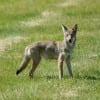 By Jim Stevenson
By Jim Stevenson
“Back to birds very soon!” Some of you may be interested in the fact that the cool front (high pressure) we enjoyed late last week was the likely result of the tropical depression (low pressure) hovering in the ocean south of us. Opposites attract. We wouldn’t normally get cool fronts in mid-August but the depression “sucked” the cooler air down our way. And of course, when it did, we had a nice wave of migrants – earlier than usual – move past Friday morning. By Saturday morning, they had apparently moved on further south. It’s kinda neat how the abiotic (nonliving) environment and the living (like birds) work together. It’s akin to the Gaia hypothesis.
On an unrelated line, many of you know of my long-time friendship with a lovely birding lady in Virginia, named Sarah. She has been battling cancer for years, and I thought we had lost her. I am happy to report that she is BACK AT WORK (is that a good thing?) and in good spirits. As most of you also know, this was a very difficult past year for me, and Sarah’s perseverance and strength was a beacon and example to me. But in a strange twist, her brother goes in for major surgery today and perhaps you could think good thoughts for the two of them. Anyone into decent music may
appreciate his recent u-tube appearance.
http://www.youtube.com/watch?v=7mlejyil5_E
Third and last, the dates and times for the open houses beginning next week are Thursday the 29th, Saturday the 31, Monday the 2nd (Labor Day) and Wednesday the 4th (Rosh Hashana). [No, Anna does NOT do hash that day!] {Sorry, Ciona!} Winking smile We will meet those mornings at 8:30 am (the best part!) in the cul-de-sac and watch circum-Gulf migrants passing by, before we go up to the house (so potty before arriving) and PLEASE don’t come up to the house early unless you have an emergency. When we go up, anyone who doesn’t walk well may park up top. OK?
Obviously, there will be more people Saturday and Monday. Birding varies WILDLY at that time from day to day, so it’s possible we MAY drive down to San Luis Pass at 10:30 am if there’s not much around that day in the yard. Ya never know!
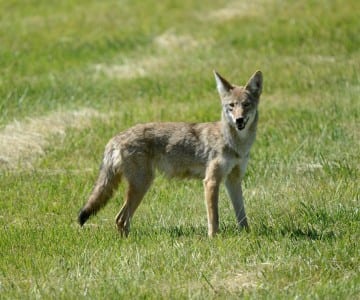
Coyotes are all over the West and much of the East, although many are far from easy to see. This one was in a CA agr icultural f ield and instantly bolted when my shutter went “click.” One has to admire the survivability of the species, but perhaps feel bad that they have displaced the Red Wolf in so many places (like East Texas).
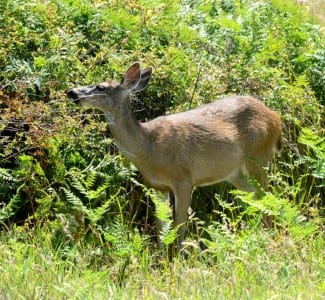
It is amazing to me how many places deer have become neighborhood pets, almost. This mom had the munchies while her youngster milled around. We have two deer in the West but only white-tails in the East. Out West, Mule Deer seem to prefer open flatlands while white-tails (I see) are more in the mountains. (If I am wrong, p lease write in.)
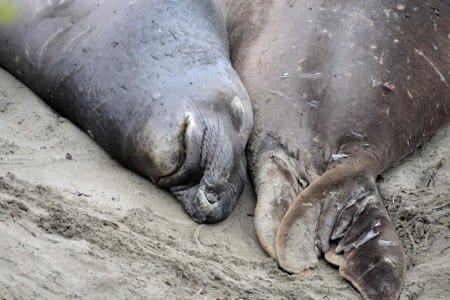
If you want to see the amazing Elephant Seals in the US, try the road up the coast from San Francisco (seasick alley) and there’s a large colony of them having fun on the beach and surf. They are named for the “trunk” (it’s actually called “truncated”) and you can see the cuts that I would attribute to combat and sharp rocks.
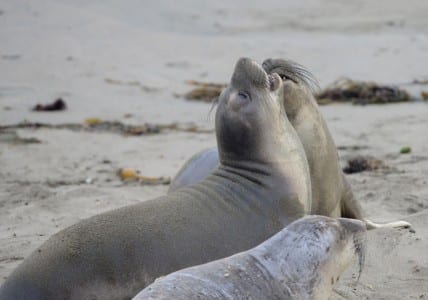
These two young males are going through the motions, but later in life the combat will be serious, as they vie for gals. (I thought about having a talk with them.)The whiskers are sensing tools for underwater foraging, as they feed entirely underwater. The female on the right seems to wish the two youngsters would just settle down.
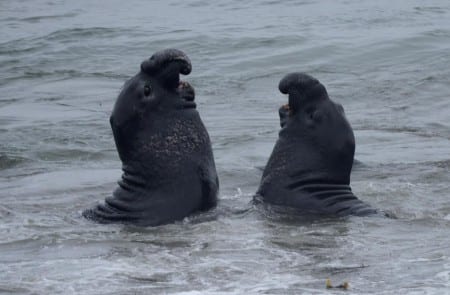
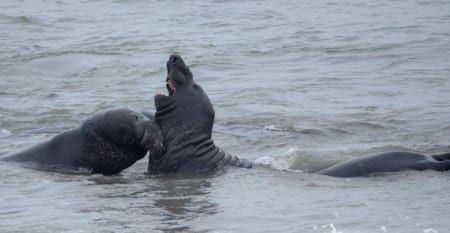
Above is a confrontation between two adult males that is getting ugly. They hit each other with those huge teeth and often inflict nasty scars on the neck and head. All this is to establish dominance and one day to pass on his genes to future generations. It seems a bit violent, but is infinitely preferable to rifles and knives.
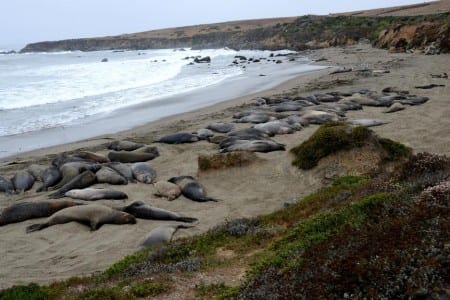
Above is the main beach where the Elephant Seals lay out and rest. They have no land predators (if humans behave) but there are Great White Sharks in the waters. They have quite the sweet tooth for mammals, although their taste for humans is overrated. Many of their attacks on surfers were probably mistaken identity. From underneath, a surfer laying on a surfboard, limbs flailing, look something like a seal, to an animal whose IQ is registered in decimal points. (Say that while swimming sometime.)
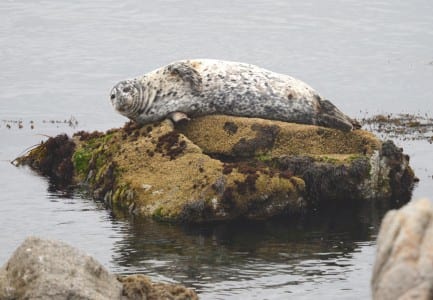
I believe this is a Harbor Seal that seems nonplused by the barnacles it’s laying on. I snuck (ok, sneaked) through the steep rocks to get this shot and was prolly the first human in years to be that stupid. But with no broken bones I arrived, and the seal hardly gave me a glance. (seal of approval?)
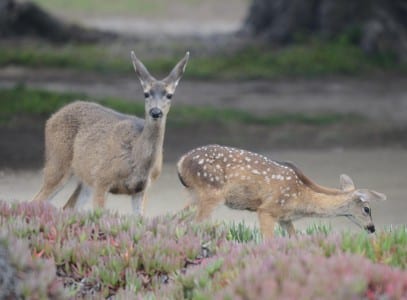
Those ears could only belong to a Mule Deer. Or a freakin’ elephant! Large ears are for heat dissipation (etc.) (such as in elephants) and lowlands where Mule Deer live get hotter than mountainous areas. Always a relationship between structure and function. I am just a bit surprised these deer were enjoying those salty succulents so much. Yuk!
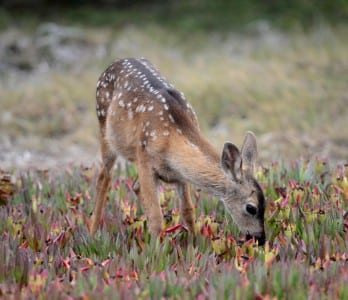
Some places in the “wild” feel like a zoo. I am always vigilant, for instance, when birds are getting unwary at my drip, that snakes, cats and hawks don’t take advantage of it. Of course, two of those are natural parts of the environment, but the tameness birds get at a feeder is unnatural and shifts the balance.
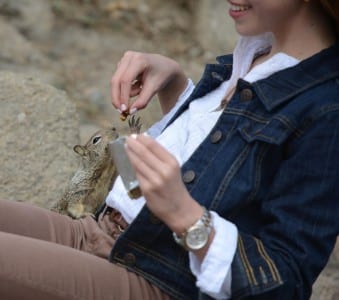
Speaking of getting tame, this ground squirrel is just downright ridiculous! They are fed in droves along the CA coast, and I guess everybody is having a good time. Still and all, I can’t help but wonder how many people get bitten, if not unwittingly by the animal, and they do carry diseases. (It’s my job to be the adult.) But it does look like a lot of fun to feed those furry little buggers.
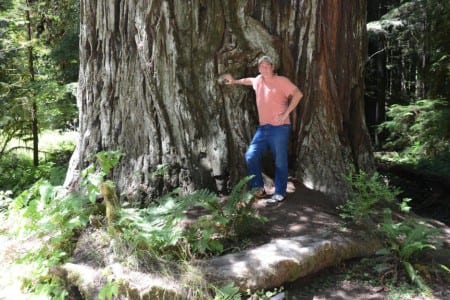
Here is the obligatory Redwood, one of many things CA can be proud of. (I gained so much weight over the summer that it’s nice to be in front of something that makes me look smaller!) Barely. These giant trees have relatives in Asia and Florida (cypress), but not it the rest of the World. Scientists are at a loss to explain how this happened. Bill?
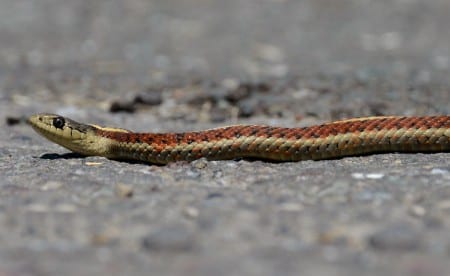
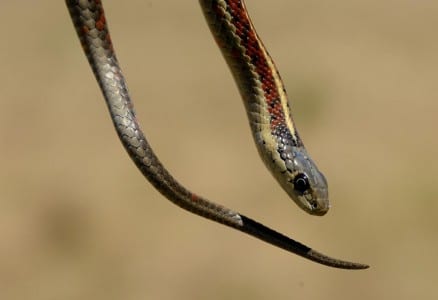
I believe this to be a Coast Garter Snake, one of the terribly confusing garter snakes of the West. I love their genus name, Thamnophis, as it means “thicket lover.” This genus can eat some of the most noxious creatures alive, including slugs and toads, and their adaptability is renowned. Note the round pupil of our nonpoisonous snakes.
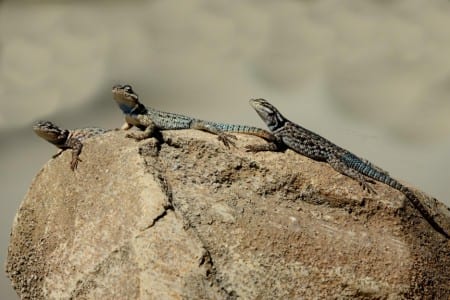
There’s a large genus of Sceloporus lizards across the country known by names like fence lizard or fence swift, and this seems to be the California version. They aren’t too terribly hard to catch,* so if you do, turn them over and stroke their belly. They’ll “go to sleep.” This genus has quite rough backs, looking like bark, as well as being the color of bark. This makes them both examples of cryptic coloration as well as mimicry. Wowsers! *These may easily be found and captured on the last part of Sun Dew Trail in the Big Thicket, north of Kountze, Texas. It’s also a great place to see pitcher plants.

 Posted in
Posted in 
























